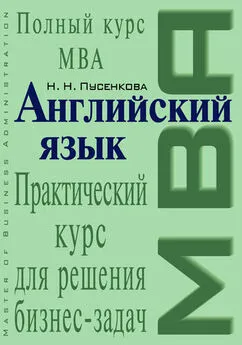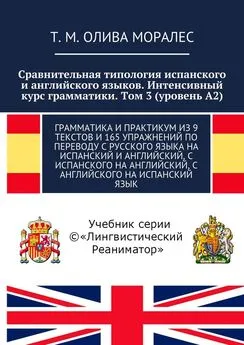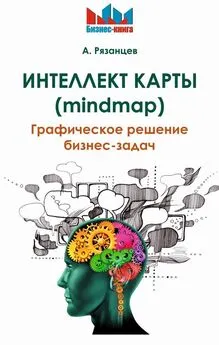Нина Пусенкова - Английский язык. Практический курс для решения бизнес-задач
- Название:Английский язык. Практический курс для решения бизнес-задач
- Автор:
- Жанр:
- Издательство:Эксмо
- Год:2008
- Город:М.:
- ISBN:978-5-699-29820-4
- Рейтинг:
- Избранное:Добавить в избранное
-
Отзывы:
-
Ваша оценка:
Нина Пусенкова - Английский язык. Практический курс для решения бизнес-задач краткое содержание
Для студентов бизнес-школ, языковых, финансовых и экономических вузов, а также для всех, кто хотел бы усовершенствовать свой деловой и финансовый английский.
Английский язык. Практический курс для решения бизнес-задач - читать онлайн бесплатно ознакомительный отрывок
Интервал:
Закладка:
Value-Chain Analysis
In order to better understand the activities for a competitive advantage, one can begin with the generic value chain and then identify the relevant firm-specific activities. Process flows can be mapped, and these flows used to isolate the individual value-creating activities.
Once the discrete activities are defined, linkages between activities should be identified. A linkage exists if the performance or cost of one activity affects that of another. Competitive advantage may be obtained by optimizing and coordinating linked activities.
The value chain also is useful in outsourcing decisions. Understanding the linkages between activities can lead to more optimal make-or-buy decisions that can result in either a cost advantage or a differentiating advantage.
The Value System
The firm’s value chain links to the value chain of upstream suppliers and downstream buyers. The result is a larger stream of activities known as the value system. The development of a competitive advantage depends not only on the firm-specific value chain, but also on the value system of which the firm is a part.
Source: www.quickmba.com
PEST Analysis
A PEST Analysis is an analysis of the external macro-environment that affects all firms. PEST is an acronym for the Political, Economic, Social and Technological factors of the external macro-environment. Such external factors are usually beyond the firm’s control and sometimes present themselves as threats. For this reason, some say that «pest» is an appropriate term for these factors. However, changes in the external environment also create new opportunities and the letters sometimes are rearranged to construct the more optimistic term of STEP analysis.
Many macro-environmental factors are country-specific and a PEST analysis will need to be performed for all countries of interest.
Political Analysis
–Political stability
–Risk of military invasion
–Risk of nationalization
–Legal framework for contract enforcement
–Intellectual property protection
–Trade regulations & tariffs
–Favored trading partners
–Anti-trust laws
–Pricing regulations
–Taxation system – tax rates and incentives
–Wage legislation – minimum wage and overtime
–Work week
–Mandatory employee benefits
–Industrial safety regulations
–Product labeling requirements
Economic Analysis
–Type of economic system in countries of operation
–Government intervention in the free market
–Comparative advantages of host country
–Exchange rates and stability of host country currency
–Efficiency of financial markets
–Infrastructure quality
–Skill level of workforce
–Labor costs
–Business cycle stage (e.g. prosperity, recession, recovery)
–Economic growth rate
–Disposable income
–Unemployment rate
–Inflation rate
–Interest rates
Social Analysis
–Demographics
–Class structure
–Education
–Culture (gender roles, etc.)
–Entrepreneurial spirit
–Attitudes (health, environmental consciousness, etc.)
–Leisure interests
Technological Analysis
–Recent technological developments
–Technology’s impact on product offering
–Impact on cost structure
–Impact on value chain structure
–Rate of technological diffusion
The number of macro-environmental factors is virtually unlimited. In practice, the firm must prioritize and monitor those factors that influence the industry. Even so, it may be difficult to forecast future trends with an acceptable level of accuracy. In this regard, the firm may turn to scenario planning techniques to deal with high level of uncertainty in important macro-environmental variables.
Source: www.netmba.com
Essential Vocabulary
1. SWOT Analysis– анализ сильных и слабых сторон, возможностей и угроз
2. expertise n – специальные знания, компетентность, эрудиция; экспертиза
3. proprietor n – собственник, владелец
proprietary a – собственнический, составляющий собственность
4. know-how n – ноу-хау
5. high-grade a – высокого уровня, высокого качества
6. shift n – смена, часы работы; сдвиг, перемещение; средство
shift v – сдвигаться, перемещаться; менять, изменять; убирать
7. substitution n – замена, замещение, субституция
substitute v – заменять
substitute a – взаимозаменяемый, субститут
8. profile n – профиль, очертание; краткий очерк, краткое описание
9. value chain– цепочка ценности
10. logistics n – логистика, материально-техническое снабжение
11. warehouse n – склад
12. after-sale services– послепродажное обслуживание
13. specific a – специфический, удельный, особый, характерный; конкретный, определенный
14. support activities– вспомогательная деятельность
15. procurement n – закупки, приобретение, материально-техническое обеспечение; контракт на поставку
procure v – доставать, добывать, приобретать, закупать, снабжать
16. raw materials– сырье
17. Human Resource Management (HRM)– управление трудовыми ресурсами
18. recruitment n – набор кадров, комплектование личным составом
recruiter n – агент по набору кадров
recruit v – набирать кадры
19. overheads n – накладные расходы
20. discrete а – прерывистый, дискретный, разрозненный; оторванный, отвлеченный
21. make-or-buy decision– решение производить или покупать
22. differentiation n – дифференциация, дифференцирование, установление различий, разделение; специализация
differentiate v – дифференцировать, устанавливать различия
23. upstream n – в нефтяном и газовом бизнесе – геологоразведка и добыча, в более широком смысле – производство (товаров) или генерирование (электроэнергии)
24. downstream n – в нефтяном и газовом бизнесе – переработка и сбыт, в более широком смысле – дистрибуция и сбыт
25. PEST (Political, Economic, Social, Technological) analysis– анализ политических, экономических, социальных и технологических факторов
26. enforcement n – давление, принуждение; осуществление; наблюдение за проведением в жизнь, принудительное взыскание
enforcer n – лицо, претворяющее закон в жизнь; служитель правопорядка
enforce v – принуждать, взыскивать; приводить в исполнение, проводить в жизнь
enforceable a – осуществимый, поддающийся проведению в жизнь; обеспеченный правовой санкцией, имеющий исковую силу
27. intellectual property– интеллектуальная собственность
28. anti-trust law– антитрестовский закон
29. overtime n – сверхурочная работа
30. label n – ярлык, наклейка, этикетка, бирка, марка
labeling n – классификация, наклеивание этикетки или ярлыка, маркирование
label v – наклеивать этикетку или ярлык, маркировать
31. intervention n – интервенция, вмешательство
intervene v – вмешиваться
32. host country– принимающая страна
33. exchange rate– обменный (валютный) курс
34. business cycle– цикл деловой активности
35. prosperity n – процветание
prosper v – процветать
prosperous a – процветающий
36. recovery n – подъем экономической активности после рецессии; амортизация издержек, возмещение; взыскание; остаточная стоимость фиксированного актива после амортизации; повышение курса (валюты или ценных бумаг); оживление
recover v – оживляться; получать обратно; выздоравливать; наверстывать, возмещать; выправляться; излечивать; собирать; взыскивать; выигрывать (дело)
recoverable a – возместимый, поправимый, излечимый; извлекаемый (о запасах)
37. disposable income– располагаемый доход
38. environmental consciousness– экологическая сознательность
39. diffusion n – диффузия, проникновение, распространение, рассредоточение
diffuse v – распространяться, рассредоточиваться
Читать дальшеИнтервал:
Закладка:





![Владимир Аракин - Практический курс английского языка 3 курс [calibre 2.43.0]](/books/1072035/vladimir-arakin-prakticheskij-kurs-anglijskogo-yazyk.webp)




